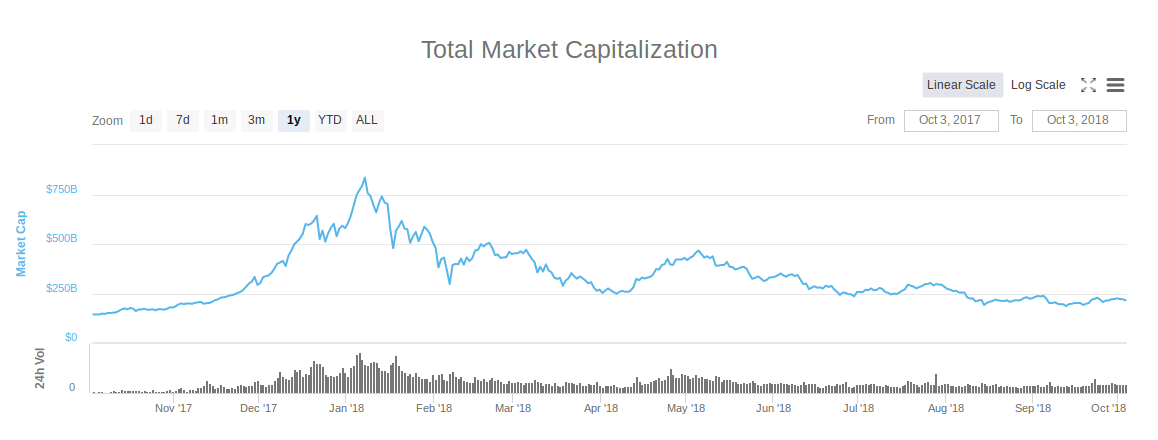
Data taken from Google search trends indicates that searches for Bitcoin have declined by 60 percent since the beginning of 2018, reaching their lowest levels in almost two years. For Ethereum, the world’s second largest cryptocurrency after Bitcoin, the stats are similar.
People aren’t just searching less for Bitcoin, they’re also buying less cryptocurrency products. As Finance Magnates reported in August, Nvidia, a graphics-card producer, confirmed that sales of its cryptocurrency-dedicated graphics cards had slipped from $289 million in the first quarter of 2018, to $18 million in the second.
Trading volumes have also declined massively since reaching a peak in early January of this year. On the 7th of January, the cryptocurrency market capitalisation was equal to just over $835.51 billion. Today its £215.91 billion – an almost 75 percent decline.
 Cryptocurrency market capitalisation for the past 12 months. Note the spike in January. (source: CoinMarketCap)
Cryptocurrency market capitalisation for the past 12 months. Note the spike in January. (source: CoinMarketCap)
Naturally, exchanges have also reported a precipitous decline in trading volumes. Trading on Coinbase, one of the largest exchanges in the world, has shrunk by 83 percent since January of this year.
Suggested articles
Meet XcelPay, Integrated Crypto Wallet and Merchant POS One-Stop-SolutionGo to article >>
Cryptocurrency – in free fall or consolidating?
There seem to be two ways at looking at this. Pessimists might say that cryptocurrencies have had their moment and are set to fade into obscurity. On the other hand, it might be better to say that, after a long, wild-west period of trading, the cryptocurrency market is coming into its own.
The huge spike in cryptocurrency trading in late 2017 and early 2018 was undoubtedly driven by people trading under the greater fool theory. They bought, thinking people would continue to buy after them, driving up the price and enabling them to sell.
Up until mid-January, that straight forward trading strategy might have worked. Since Bitcoin has been comparatively stable since then, people trading using the logic of the greater fool theory will have been less interested – or indeed totally uninterested – in trading cryptocurrencies.
In fact, though the great-rich-quick mentality lingers on, it is far less pervasive in the cryptocurrency markets than it was 12 months ago. That is a good thing. If cryptocurrency is, as its fanboys make it out to be, the currency of the future, the market for it can’t be populated almost exclusively by people who are only in it for the short-term.
A positive development for now would be to see an expansion of cryptocurrency payments products. If the price of cryptocurrency lowers in volatility that would be a good thing for the long run as it would enable its wider adoption. No serious business is going to accept payment in a currency that loses half its value one day, doubles the next and then declines by 25 percent the day after that.
Conversely, if the price of cryptocurrencies remains stable, that would allow businesses to start taking it as a form of payment. That would silence many of the critics who say that cryptocurrencies have no use and no real value.
For that to happen, however, the industry needs to rid itself of its get-rich-quick hustlers. Once all of those wideboys are gone, cryptocurrency might start to live up to its potential.

Financemagnates.com is author of this content, TheBitcoinNews.com is is not responsible for the content of external sites.
Our Social Networks: Facebook Instagram Pinterest Reddit Telegram Twitter Youtube










